Next up in our Battle series we have the Battle of the Naked mid-range bikes and we put the Triumph Street Triple 765 RS/R and Honda CB750 Hornet up to the test, let us know in the comments who is your winner…
Triumph Street Triple 765
You always know a bike’s good if it’s going faster than you think it is.
So it was a bit of a moment on the launch of the Street Triple when I glanced down at the speedo to see a figure which would have meant that if any Spanish traffic cops had been about, they would have flung me in jail and thrown away the key.
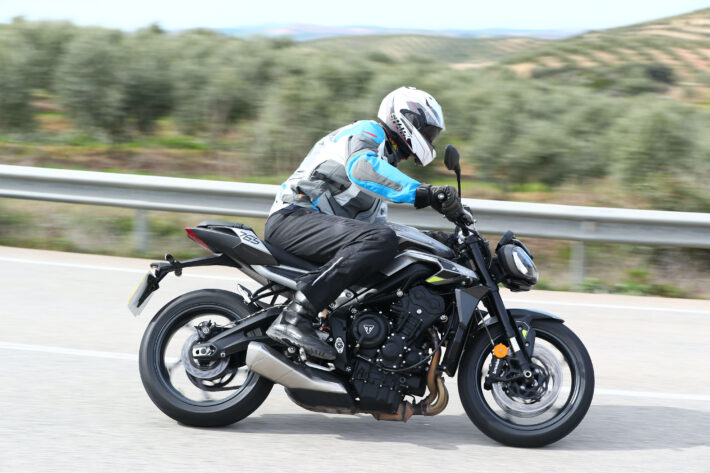
Whoops. Mind you, it was hardly surprising, since the outgoing Street Triple was already the best naked street bike on the market – fast yet user-friendly, with blistering acceleration and trademark Triumph nimble handling.
It was originally launched in 2007 with a 675cc engine producing 100bhp, and in 2017 that was increased to a 765cc one making 113bhp.
Either way, it’s been so popular that Triumph’s sold 130,000 of them, so it was always going to be a tough one to improve on – and top marks to the Hinckley boffins for doing just that.
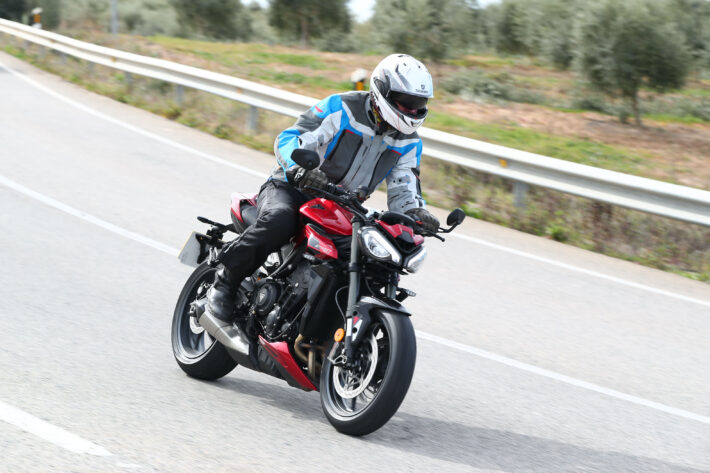
Using the knowledge gained from the very successful Triumph engines used for Moto2 racing, they threw most of the bits of the previous Street Triple engine into a skip out the back, stuck in new ones, and made all the gear ratios except first shorter for even better acceleration, more of which in a bit.
It certainly looks great, with more aggressive styling to suit the increased power and torque, and a steeper fork rake and wider bars to improve the already brilliant handling.
Climb on board, though, and for a bike that looks all set for a race, it’s surprisingly comfortable even for the taller motorcyclist.
Even better, the RS I was riding was fitted with bar end mirrors, giving fabulous rear visibility.
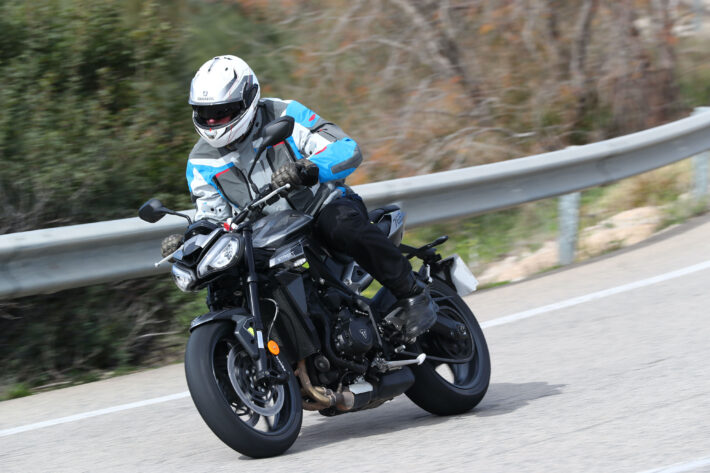
With 7bhp more than the previous version of the RS, the bike weighing a featherweight 189kg and those shorter gear ratios, progress is deliciously thrilling even in Road mode, the others on the RS being Rain, Sport, Rider for individual tweaking, and Track, and on the R all of those except Track.
Quickshifters, which used to be clever but clunky, are getting better all the time, particularly Triumph ones. The one on the Speed Triple 1200 RR I’d ridden the week before was superb, and this is just as good, even in first and second gear, which used to be unheard of.
Even better, although it was formerly an optional extra on the R, it’s now fitted as standard on both it and the RS.
Handling, thanks to light weight, steep fork rake and trademark Triumph magic, is superbly light and clinically precise, allowing you to fling the bike into corners without even having to think about it, then out the other side glorying in that seamless surge of power.
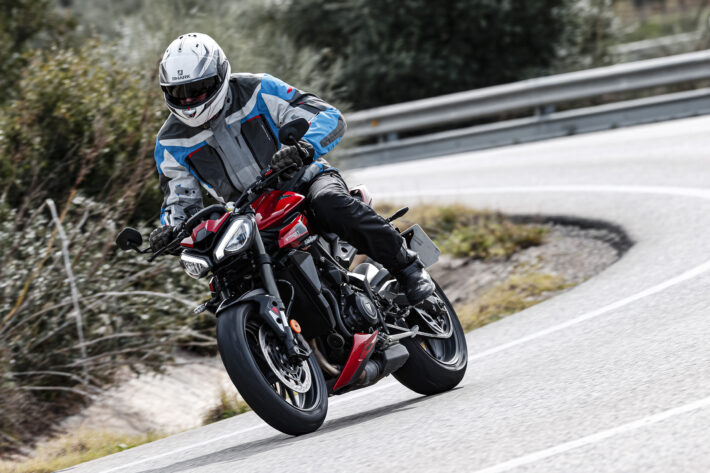
The cornering traction control works perfectly, as I discovered when I crossed a slippery white line coming out of a bend. The back end stepped out momentarily, and the bike sorted itself out instantly with no input from me. The cornering ABS is also a useful safety blanket for misguided application of anchors while heeled over.
Braking is as brutal and effective as acceleration, and with the front and rear brakes linked in perfect harmony, you don’t even need to trail the rear into downhill corners.
Sport mode adds a more aggressive edge to progress, although to be honest, Road’s so swift and smooth that I preferred it.
So far, so fabulous, with the only complaint the TFT screen on which all the info you need is there at a glance except for the revs, since the tacho is as bad as the rest of the bike is good.
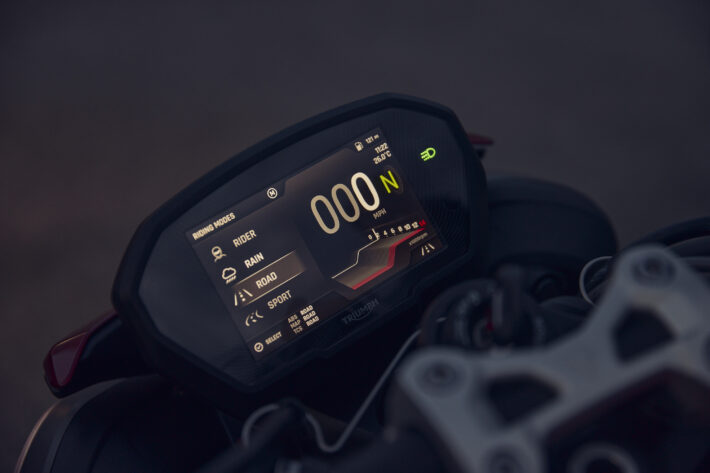
Right, time to change to the cheaper R, which has a more old school dash, but a much more readable tacho.
It weighs 1kg less than the RS, but has 10bhp less power, so progress is marginally less exhilarating, and with a gentler fork rake than the RS, steering’s a bit slower, requiring a positive push on the bars to tip into corners compared with the featherlight touch of the RS.
So if you’ve got the dosh, go for the RS, especially in the lustrous red colour and with bar end mirrors, which keeps the Street Triple firmly crowned as the king of naked street bikes.
Honda CB750 Hornet
Colin Chapman, the legendary designer whose Lotus cars transformed Grand Prix racing in the Fifties and Sixties at the hands of drivers like Graham Hill and Stirling Moss, was once asked his secret.
“Simplify, then add lightness,” he said.
He didn’t apply it to himself, since his nickname in the pits was Chunky, although never to his face – but Triumph obviously took heed of it with the 189kg Street Triple RS and the 188kg R above, as did Honda with the Hornet.
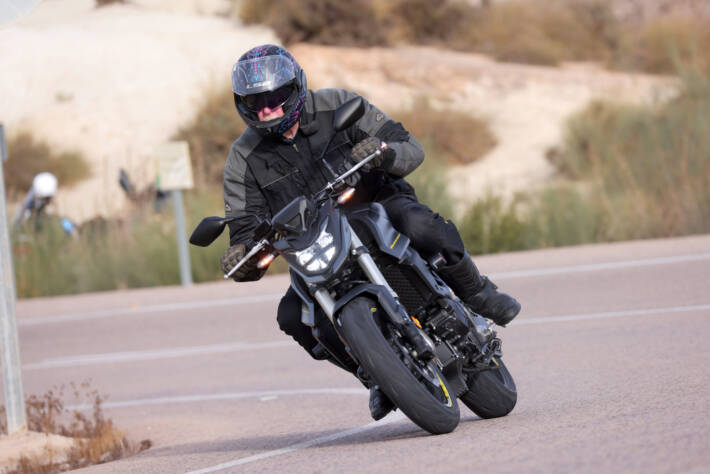
For a start, it’s simple in not having anything it doesn’t need, and secondly, it weighs a piffling 190kg fully fuelled.
Just to put that into context, it’s about five Victoria Beckhams, or half a plus-size influencer.
I suspect Honda did it by filling the tyres with helium, but even with that parallel twin engine producing a modest 90bhp compared with the 118bhp of the Street Triple R and the even more lusty 128bhp of the RS, a power-to-weight ratio like that promised exciting times at the launch in southern Spain.
It certainly looks like a lovely little machine, and feels like it when you climb aboard, with the nicely sculpted seat a low 795mm, slightly rear-set footpegs and wide bars making for a riding position which is compact but comfortable, and just slightly on the sporty side of neutral, allowing your pinkies to rest lightly on the bars, which is always a harbinger of effortless cornering ahead – especially combined with low and light weight, wide bars, a short wheelbase and a relatively steep fork rake.
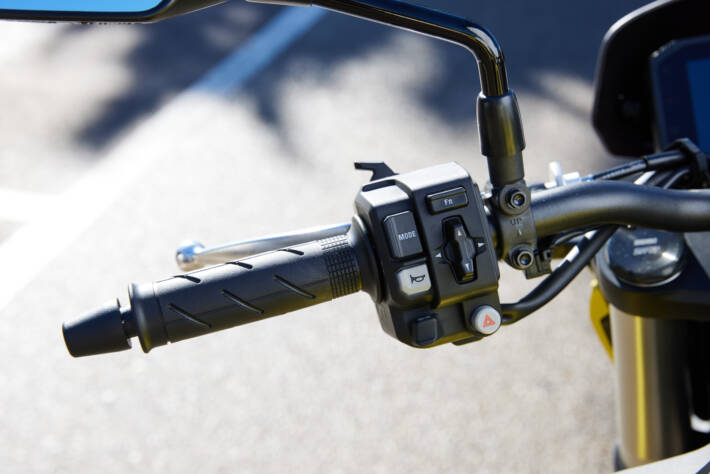
The mirrors are OK but not great, and the 5in TFT screen is clear and instantly informative, giving you all the main info at a glance, including speed, revs, gear and riding mode.
There are four of these – Rain, Standard, Sport and User for inveterate tweakers, who can delve into sub-menus to change everything from power delivery and traction control to the levels of ABS intervention and engine braking.
Slightly less geeky types can change the look of the screen, and the rest of us can just change the riding modes at the touch of a button on the left bar.
I started in Standard, and as expected, with 90bhp shifting a mere 190kg of bike, progress is gloriously lusty.
My biking buddies who know more than I do said that short-stroke oversquare engines like this usually get most exciting at very high revs, but thanks to a very flat torque curve, the Hornet’s pulls cleanly all the way from about 2,500rpm all the way to the redline at 10,000.
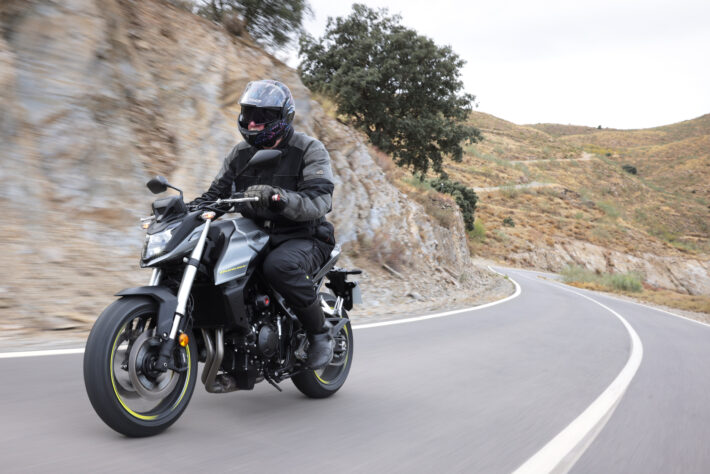
The only slight hiccup was slightly snatchy fuelling off a closed throttle, but you can blame the emissions strangulation of Eurocrats for that, not Honda.
The bikes we were riding were fitted with the £240 optional quickshifter, which was slightly clunky in first and second gear, as quickshifters tend to be, but otherwise slick and efficient.
Mind you, the clutch was as light as the shadow of a small feather, so using it was hardly a hardship, and with the engine pulling so enthusiastically through the rev range, most of the day on curvy mountain roads was spent happily bombing along in third and fourth.
Not to mention enjoying the exquisite symphony from the exhaust, which has been tuned to produce high frequencies from one outlet, and low from another, which means you can have endless fun playing tunes by covering one then the other with your glove. Very silly, but such a very Japanese attention to detail.
After all, this is a country which had an entire team fine-tuning the exhaust note on the Mazda MX-5. I used to have one, and what a great little car.
Back on the bike, meanwhile, and an even bigger joy than the engine is the beautifully agile, precise and instinctive handling, which is the best on any bike I’ve ridden this year. Or possibly ever.
The brakes are also brilliant, with progressive bite and feel, including the rear, making even tight downhill hairpins a doddle to swish around trailing the back brake to keep the bike stable.
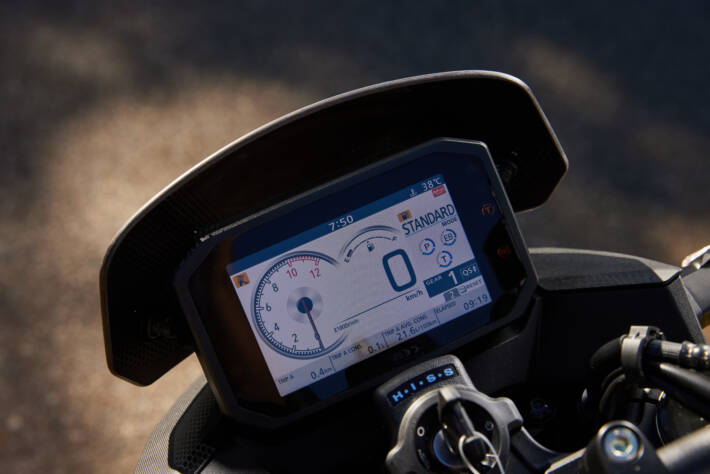
Right, time to try Sport mode, which wasn’t hugely different, apart from an even bigger rush of whoosh at the top end of the rev counter, although I did notice the steering feeling a little light at very high speeds. Dear Mr Spanish policeman, please ignore that bit.
There’s an A2 conversion kit available, which means newbie riders could have loads of fun on this, then even more when they can derestrict it after two years or when they hit 24.
Some people criticise Hondas as being reliable, but bland and unexciting, to which the reply is: “Yeah, right. Like John McGuinness winning the TT on a Fireblade, you mean?”
But this great little bike has a raw, aggressive feel to it which will silence even those naysayers, who I suspect may never have actually ridden a Honda.
I loved it. What a fabulous machine, especially at that price.
The verdict
There’s a reason why Triumph has sold 130,000 Street Triples, and this latest version proves why it remains the king of naked street bikes.
It’s swift but smooth, handles more precisely than a surgeon’s scalpel and has a brilliant quickshifter, and that cornering ABS and traction control on the RS will get hamfisted idiots out of trouble even before they know they’re in it.
The only minor complaint is the useless tacho on the RS, but I can forgive it that for those fabulous bar end mirrors.
Having said all that, the Honda may have less power than both the Triumph R and RS, and no cornering ABS or traction control as on the RS, and the optional quickshifter isn’t as slick as the Triumph’s, but the handling’s just as sharp as the RS, if not better. It’s certainly better than the R.
And most of all, what an astonishing and fun machine it is for less than seven grand. Even the basic Street Triple R is £2,596 more.
So if money’s no problem, go for the Street Triple RS, but if like all of us you haven’t got limited resources, the Honda is a bargain blast which I’d prefer to the Street Triple R.
The Facts
Triumph Street Triple 765 R/RS
Engine: liquid-cooled 765cc inline triple
Power: R 118bhp @ 11,500rpm; RS 128bhp @ 12,000rpm
Torque: 59 ft lb @ 9,500rpm
Colours: R silver; white. RS silver; red; yellow
Price: R from £9,595. RS from £11,295
Honda CB750 Hornet
Engine: 755cc parallel twin
Power: 90bhp @ 9,500rpm
Torque: 55 ft lb @ 7,250rpm
Colours: Black; grey; white; yellow
Price: £6,999
Former Sunday Times and Daily Mirror motorbike columnist Geoff Hill has joined the Devitt team to bring decades of alleged motorcycling wisdom – and at 6ft 7ins, some much-needed height.
He’s been testing bikes since 1998, has ridden pretty much everything out there, and kicks off with a series of comparisons on everything from full fat adventure bikes to scooters.